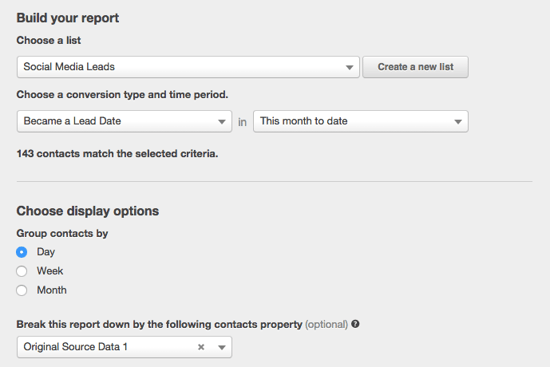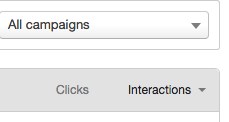Take a walk with me.

You are the Social Media Manager, Community Manager or Marketing Manager who runs social on the side (or just a social enthusiast) and your boss asks you how your social media marketing is doing this month. Usually posed like this:
"Are you 'killin it'?"
This is a question I get weekly from my manager as well as ad-hoc from my deskmate, HubSpot’s CEO. Being able to give a meaningful answer to how are we doing on social is the golden unicorn of the social world.
Want to learn about social media promotion? Check out this lesson.
There are so many metrics that can be measured in social media, that sometimes it can be overwhelming to narrow it down to something bite-sized, and find a good measure of success. Since social media also touches everything from attracting prospects to delighting customers in the buyer’s journey, figuring out what metrics to report on can be a challenge.
In this post, I will break down the metrics we observe at HubSpot, how we define success, and how we make that decision each month. And the best part: we'll wrap up with how to actually measure those metrics at HubSpot.
The Social Setup
HubSpot is a social company, so most departments have a presence on social networks, and each of these departments defines success differently. The ‘corporate’ handles are run out of the Marketing Team. This is because social, like any consumer-facing communication, is a channel that converts leads. According to a report by Social Media Examiner, by spending 6 hours per week on social media, over 66% of marketers see lead generation benefits.
Just like email, organic or co-marketing partnerships, using a tool like Social Inbox or the Sources Report, we can see the leads that converted after visiting us on social. Since we can calculate how many leads came from social, and we can calculate the average cost per lead, we are able to determine where social fits into the marketing strategy.

Since social is a lead-generating channel, the team is most closely aligned with the marketers at the top of the funnel, but it almost has a layer of its own atop the funnel, taking people from first seeing the accounts to ultimately converting to leads. Where exactly to focus energy in the funnel each month is an important question.
Our Metrics
Of course, as marketers, we want to know as much as we can about as many data points as possible. An experiment without results may as well never have happened, right? Since our team has already proven that social is important for getting leads into the funnel, we think next about what metrics will best help us get there. There are several things that we look at on a month-to-month basis on our team.
The Big 4
We start with looking at the big four metrics, the data points everyone talks about when devising a successful social strategy. We mentioned that social media is at the top of the funnel. Each of these metrics represents a different stage of the social funnel. Here are our metrics:
- Reach. The metric lives at the top of the social funnel, and analytics software providers will define this differently. Reach can be defined as the potential impressions for your audience (ex. number of people in your audience plus number of people in their audiences). It can also be defined as your net followers, which means how many people actively follow and receive your updates. At HubSpot, we measure it as the latter. We have the ability to measure this with the HubSpot Reach Report, but often we incorporate networks like Pinterest and SlideShare, so we record those stats manually in a spreadsheet.
- Engagement. The next step to conversion, engagement, is defined as how many interactions people have with your posted messages. This can include mentions, replies, comments, likes, favorites, +1s, and retweets. Clicks are measured separately since they're more closely related to traffic. We are able to measure these in aggregate in Social Inbox, but most channels also have the specific analytics available on their own platforms.

- Traffic. Traffic is defined as how many visitors are coming from your social posts to your website. This is typically measured in a Sources Report. HubSpot provides this kind of tool, as does Google Analytics.

- Leads. Leads are the ultimate goal of an ROI-driven social strategy. Social leads are people who have found you on social media, clicked on a piece of content, and filled out a form to receive more information, opting into email communication with your company. At this point, they are passed off to our MoFu marketers for nurturing through email (although we do social nurturing as well, on a smaller scale). For this metric we look at how many new leads we got to the software that came in with an original source (first touch) of Social Media. You can find this information in the Sources Report, too:
Other Interesting Metrics
While social lives at the top of the marketing funnel, there are plenty of other places that can benefit from social care. Even though not everything is directly related to lead generation, being a lovable company extends to social media and is important because it makes us worthy of people giving us their email and ultimately being our customers. As such, we also keep aware of a few other metrics on our social team:
Response Time. While we don’t have a specific metric to track how fast we respond, our goal is for the majority of tweets to be responded to within 24 business hours, and we are able to see in Social Inbox how long it's been since the last tweet. The quicker the better.
Social Assists. We keep an eye on approximately how many people touch social at some point in their lifecycle before becoming a customer. This is done through an attribution report in our tool, and can help give an idea of our audience influence.

CPL (Paid Social). This stands for Cost Per Lead, and relates to how much money it costs to get someone to click on an ad or promoted post. Primarily this is used to gauge how well our ads or boosted posts are performing (Cost per Click is also often measured for leads).
There are plenty of other metrics you can measure like social's impact on nurturing or percentage of tweets responded to, but we found these seven were the right ones for the social team. All together, that is a lot of metrics. Tracking them all can be overwhelming. The key is not letting success be defined by all of them at once.
How We Define Success
As I mentioned, the social team sits at the top of the marketing funnel, so ultimately, our success needs to be defined by generating more leads at a lower cost (ROI), but we have a bit of flexibility in how we get there.
When I first started working on the social team, the team was measuring the four metrics listed above: traffic, reach, engagement and leads. In adding human bandwidth to the team, the first thing we did was to create more metrics to measure performance.
What we soon realized that by holding ourselves to so many metrics, we weren’t focusing or optimizing for the success of one, thus we didn’t know how well we were doing. This also created confusion, since meeting half of our monthly goals could be considered a “success.” Not helpful.
We then decided to take a drastic course of action. To only focus on one metric at once! We keep an eye on all metrics of course to look for anomalies, but to pick one for which we would be responsible to our leadership team and the for which we would economize our time and balance other team asks. This allows us to dive deeper in reports and campaigns for that one goal, and hit it out of the park. The first few months in this plan, we decided to aim for a “Leads” goal, but last month decided to switch to a “Reach” metric.
Why leads and reach? Great question.
Our Process
When creating the looking at our social experience we ultimately want it to do three things: create a loveable social experience for followers at all stages of the funnel, capture share of voice (influence in our space) on social platforms, and generate social leads. If keeping a close eye on the metrics above, we can see if one of these areas in general is falling behind, and where any flaws might be in our funnel.
We also spend some time thinking about our last few months. What has the trend line looked like the last year? Why? What do we need to do to optimize the funnel? We then make decisions about what will ultimately contribute to success and run with them.
We then spend a little time getting crazy. We set a SMART goal. More on how those work here. We challenge ourselves to hit a lofty goal. Not so lofty it’s impossible, but just lofty enough we’ll scramble to hit it. Otherwise, what’s the fun, right?
An example of this is how we decided on the reach goal for this summer, instead of our usual leads goal. Last November our team looked at the last two years of social media and determined our leads had declined, a kink in the funnel we surely had to fix. What we realized was that we weren't filling the top of the funnel with our reach as well as we had before. We first made sure the bottom of the funnel was working, by optimizing for good social practices (ex. frequency of offers, wording, images etc) and then decided to drive more people into the funnel to help increase that number. We decided we wanted to blow our usual reach out of the water, and run towards that goal.
Then the fun begins -- brainstorming how to be successful with social media marketing.
How we really “MEASURE” success
When doing anything at HubSpot we start with a simple question: how will I know if I’m successful? Then we ask, what will we use to measure? Then we set up a report to measure it. That's because at the end of the day, regardless of the numbers I've hit, what I need to be able to explain is "why". To help measure that, I’ve set up several reports based on what we’re optimizing for that month, but I consistently check the following reports at least twice a day:
1. Progress on Leads.
This is a Contacts Report we set up in HubSpot to measure whether we’re on track to hit our leads goal this month (You can set one up like this too, if you're using HubSpot Professional or Enterprise, both of which you can try for free.)To to this, we first create a list of all our social leads. Under “Contacts” and “Lists” we create a new list with the criteria “Contact Property”, “Original Source Type”, “Is Equal To” and “Social Media". Check out the screenshot below for an example:

We then create a contacts report on that list to see everyone on that list who has converted this month. Under “Reports Home” we create a new “Contacts Report”. We use our list of Social Media leads and choose conversion type “Became A Lead Date” and time period of “This month to date”. This lets us see who on the list of social media leads became a lead this month. By grouping these contacts by day, we are able to see the daily trendline. By additionally breaking it down by “Original Source Type” we are able to see which networks in particular are converting the most leads.

BONUS: by setting a monthly goal number, we can see a projection per day, and if we are hitting that number, so we know if we need to run to catch up!
2. Net Reach Increase.
Each day I check the follower count of each of our networks and record it in a handy Google Spreadsheet. I get several of these numbers from our Reach Report, but I supplement additional networks like Instagram and SlideShare on my own.Each day when I record the follower count, I can calculate how much of an increase that was from the previous day (again, trends are important). I can also calculate if I want to increase our followers by a certain number a month, how many that is per day. Then I check what percent I’m at today of where I should be. For example, let’s say I want 30,000 leads this month I need 1,000 a day (may be adjusted for business days). If it’s the third day of the month, and I only have 2700 leads so far. I’m at 90% of goal.
3. Engagements.
This one is easy to take straight out of your publishing platform. For me that’s Social Inbox. I check which posts are receiving the most engagements and clicks. While they may not be driving towards a certain goal, I use this benchmark to know the kind of content people are enjoying. This is especially useful if I’m trying to run any A/B tests on the type of content.This can be accomplished by going to Social Inbox's Published dashboard, then publishing and filtering by posts in a certain timeframe with certain clicks.

Each of these reports helps to determine the health of the funnel. While each of these reports serves an important purpose to me, I find I try to optimize for one at a time while keeping an eye on the others to make sure nothing goes drastically wrong. I do, however, want to have an idea of what’s happening around me, because at the end of the day:
The most important part of success is knowing why.
At the end of the month either way, we want to be able to say we did hit the number we set out to hit, and this is that we did to hit it. That way it can be replicated or fixed for the next time. That is how we determine a successful team at HubSpot, and that's how we measure the success of our social media marketing.
What other tips do you have for measuring your social media marketing? Let us know in the comments!









